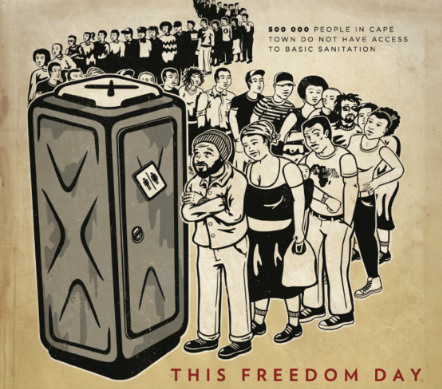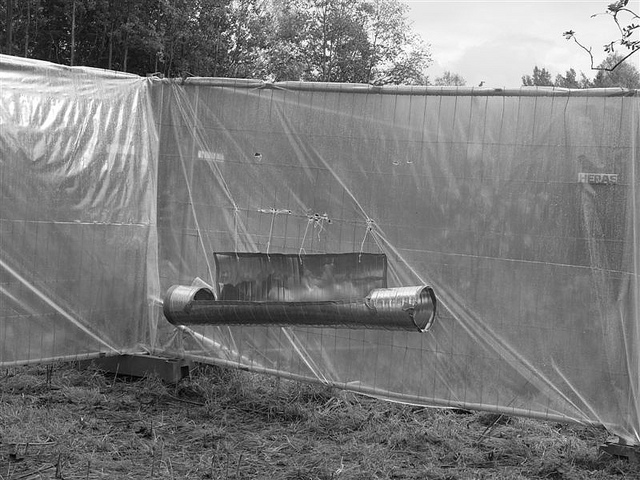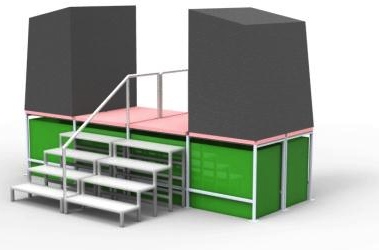
Urination and long toilet queues
Lack of access to sanitation in emergency camps often leads to indiscriminate urination, especially if there are long toilet queues. Moreover, the limited number of toilets present are used inefficiently: people who urinate take the space of people who want to defecate.
Urinals as a solution to increase efficiency of toilets
The introduction of ‘public’ urinals is expected to boost the efficiency of existing toilets. It is to be expected that these will boost the use of sanitation facilities, reduce the waiting time for toilets and thus prolong the lifetime of dug pits and raised latrines. This urinal should be attractive and safe to use, lightweight to transport by air to emergency situations and easy to install. The urinal needs to be equipped with a urine storage container. As a guide, a urinal that served fifty people and was emptied on a two weekly basis, with each person producing 1? per person per day, the tank would need to be around 1m3.
Design Criteria
| Nature of solution | A versatile kit for a urinal, consisting of the structure to raise the urinal and a container for collecting the urine which allows emptying. |
| Configuration | The solution should be a block of urinals, an individual urinal or, ideally, be configurable to both situations. |
| Size and shape | Emergency organizations existing pit latrine slabs are 1200 x 800mm. The solution should preferably fit on the existing slab, although alternative solutions may be considered. |
| Male and female / adults and children | The solution may cater for male and female, adults and children. |
| Disabled Users | The solution may cater for disabled users, although this is not essential as alternative solutions could be found. |
| Durability | Minimum two years. |
| Weight | On arrival in the country, the solution will need to be man-handleable. |
| Packaging | The solution should pack small for ease of shipping. Ideally, the solution will fit on an EUR-pallet. |
| Construction method | The solution should be quick and easy to use, requiring little or no skill. |
| Local Materials | The solution should be a complete kit, not requiring any materials to be sourced in country. |

Objective:
Provide urinals (for men and women) to decrease the filling up of the pit latrines.
Activities:
To raise the interest of the general public in the topic of emergency sanitation, WASTE organized a design contest on this issue. The contest was launched just before World Water Day 2013 on 18 April on line through WASTE, SuSanA, TUD, etc. The rules were explained in a Leaflet and the Emergency Sanitation Project website. Later an attractive Flyer was distributed at universities, schools, Oxfam (Design a Bog day on 13 September 2013), S(P)EEDKITS, etc. The contest was mentioned in the newspapers in The Netherlands and an interview was broadcasted. The contest closed 18 October 2013, 1 month before World Toilet Day.
The design contest resulted in 14 applications from 11 different countries.
The entries have been scored and the top four entries have entered a voting on the WASTE website. Based on this voting three have been given a prize of €500.
Further work
A general comment of the relief organizations on these entries was that the designers lack the insight of the in’s and out’s of the ‘real’ conditions during emergencies. Hence, we challenged the three contestants to come up with a clear distinct proposal how they would envisage that their proposal could be brought from the drawing table to the manufacturer. This proposal would include a field visit to a refugee camp emergency situation, thus answering the concerns that the designs did not yet show they had grasped the real challenges that relief organizations are meeting in the field. Out of your three proposals one would be selected for funding up to € 5000. This would include the field trip.

By 19 January 2014 two contestants had handed in a proposal. We studied this proposal in an ESP meeting in London decided to discontinue the contest. One important reason is the doubt of IFRC and Oxfam GB that a separate urinal would ever work in an emergency situation and whether relief organizations would ever purchase it.
Hence, we decided to make it an ‘add-on’ Flexxolutions raised latrine:
Tell us your idea
If you have any products, ideas or would like to become involved in the urinal project, please get in touch with:
Jan Spit, Adviser Sanitation
WASTE advisers on urban environment and development
www.waste.nl
e-mail: jspit@waste.nl
mob: +31 6 57 99 78 74
Do you need inspiration? Watch urban pissoir.